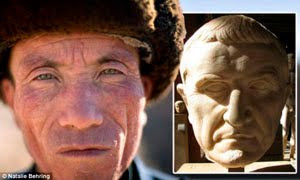The Lost Ninth Legion has been a recurring theme on this blog since 2007 (revisited in 2008 and 2009). And, with the new Eagle movie about to hit the big screen, there will no doubt be further revisiting.
But, from all of my previous posts, one which I never imagined revisiting was last year's Rome and China offering. But it seems that the theme of Romans in China is, again, in the headlines.

Chinese villagers 'descended from Roman soldiers'
This was the headline trumpeted on 23 November by no less an authority than The Daily Telegraph. Tests apparently showing 56% Caucasian DNA amongst the inhabitants of the Chinese village of Liqian, coupled with the fact that "many of the villagers have blue or green eyes, long noses and even fair hair", was enough to start the speculation that these people were "descended from the lost legion". (Don't panic -- it's not the Lost Ninth Legion, but a different one.)
The story was quickly picked up by the other newspapers (e.g. The Daily Mail) and, naturally, the bizarre theory of the village's Roman origins popped up. This was the brainchild of the late Homer H. Dubs in 1957 (in a book and article entitled A Roman City in Ancient China).
(I am surprised to see that I have not blogged on this before. It is a fascinating lesson in misguided scholarship, but must wait for another occasion.)
But, now -- thank the Olympian Gods for Discover magazine! Sanity has been restored. In an article from 29 November entitled No Romans needed to explain Chinese blondes, genetics commentator Razib Khan explains that the neighbouring Uyghur population were a Turkic ethnic group with a physical European appearance. It is quite likely that the Han Chinese, expanding their influence to the north-west, came into contact with these people. It's far more likely, at any rate, than Homer Dubs' theory of a colony of Romans!
Well, there goes another plank in the "Romans in China" theory. But, like our Lost Ninth Legion, I suspect that this story will run and run.
Do you know of any major cities in Europe and America that don't have "Chinatowns"? Furthermore, the Han Chinese have steadily expanded to what we know as modern China, displacing completely earlier populations. They are currently doing exactly this in Tibet, Chinese Mongolia, and other places. Historically they almost overan S.E. Asia, which still has large Chinese minorities.
ReplyDeleteNor do they integrate with, or mix with other populations to any great degree, in part because their cultural tradition regards themselves as "sons of heaven" and all non-chinese as inferiors.....and unlike Western governments who can't see past the next election, they are quite capable, as they have proven, of pursuing long-term goals.
This "Roman army in China" story seems to be rumbling on: Xinhuanet News (21 March 2011).
ReplyDeleteEventhough Caucasian genetic markers are discovered among the vilagers, it does not prove of alledge Roman ancestry. People with Caucasian features are known to be living in the area where Liqian is located. In Xinjiang, muumies with Caucasian features are discovered and they are several thousands years old. It is the mentioned of fish-scale formation utilized and Xiongnu soldiers and double palisade fence in Han Chinese texts that led Homer Dubs' interpretation of Roman presence in China. He identifies the fish-scale formation as Roman testudo formation. If they are really Romans, they will not be even recognized as Romans. Roman soldiers are recognized by their Roman Legionary equipment. 10,000 Romans are captured as POWs by the Parthians at Carrhea just 17 years prior to the Han Chinese battle with the Xiongnus. Dubs theorises that some are intergrated into Parthain military and are stationed in their eastern border to guard it against invaders. Some of them escaped and traveled eastward, offering their services as mercenaries to local rulers. If they alledgely appeared on the battlefield to fight Han Chinese soldiers, they are not even wearing their Roman Legionary uniform or even using legionary weapons. They are confiscated upon surrendering or captuted by the Parthians. When enemy soldiers are intergrated into the military of their new masters, they will rearmed and reequiped with new military equipment. Alledged Roman soldiers will be in either Parthian military equipment or that of the Xiongnus. If they are intergrated into Han Chinese military, they will be issued Han Chinese military equipment and live out their lives as Han Chinese soldiers. As for the vilagers of Liqian, they are most likely descended from merchants and travellers from the West that travel along the Silk Route as the village is located on its path. The Roman army itself composed of soldiers recruited from conquered territories. The army itself has soldiers from North Africa and the Middle East as well as from Europe.
ReplyDelete